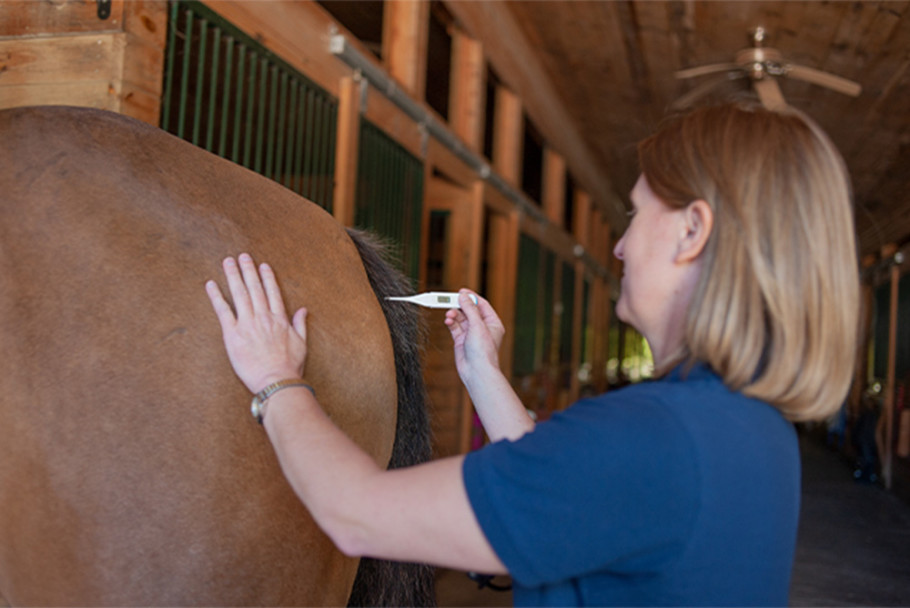Endotoxemia in Horses
By: Dr. Lydia Gray | Updated March 23, 2025 by SmartPak Equine

Endotoxemia in horses is a serious, body-wide medical condition that requires prompt veterinary diagnosis and treatment to prevent grave, even fatal results.
What is Endotoxemia in Horses?
Endotoxin is a part of the cell wall of certain bacteria (such as Salmonella and E. coli) that is released when these bacteria die, usually in the digestive tract. Normally, a healthy intestinal barrier along with a well-functioning immune system prevents endotoxin from entering the bloodstream, a condition called endotoxemia.
However, when the body’s defense systems are overwhelmed by a large amount of endotoxin released from a massive bacterial die-off or when the enzymes, antibodies, and white blood cells that serve as a second layer of defense fail, endotoxemia can occur.
Endotoxemia that is untreated or does not respond to treatment can lead to shock, a life-threatening medical condition that occurs when the circulatory system shuts down in response to trauma or illness.
Causes of Endotoxemia in Horses
Endotoxemia usually occurs as a result of another illness, and these illnesses can be divided into two categories:
- Intestinal events: By far the most common cause of endotoxemia in adult horses, intestinal events such as colic or colitis cause a break in the intestinal barrier and permit endotoxin to leak into the bloodstream.
- Non-intestinal events: Other circumstances that can result in the release of endotoxins into the bloodstream include a bacterial infection in the blood (septicemia), retained placenta in mares post-foaling, and respiratory disease such as pneumonia.

Signs and Symptoms
It is unusual for an adult horse to develop a case of endotoxemia without an underlying illness, therefore an owner will generally first notice colic, loose stool, respiratory disease, signs of a bacterial infection, or a difficult foaling.
Untreated or unresponsive to treatment, a horse that may be progressing into endotoxemia will act depressed or lethargic, standing apart from the herd or standing with the head and neck hanging low.
They may not want to eat or drink or pass much manure. Instead of being the normal pink color, mucous membranes (such as the gums in the mouth) may be paler than usual, darker “brick-red,” or have a blue or purple tinge to them.
Additional signs that a horse may have endotoxemia include a high heart rate, a high respiratory rate, fever, acute diarrhea, and signs of abdominal discomfort (colic) such as pawing, rolling, and sweating.
Veterinary Diagnostics for Endotoxemia

Endotoxemia is a condition that is better to prevent than to treat. So, the best advice is for horse owners to contact your veterinarian when you notice the first signs of health or behavioral changes in your horse. This is especially true if digestive disturbance is noted since GI tract dysfunction is the most common cause of endotoxemia in adult horses.
Your veterinarian will take a history, perform a complete physical examination on the horse, and likely draw blood for a complete blood cell count (CBC) and serum chemistry.
Of particular concern are decreased gut sounds, delayed capillary refill time (CRT) or jugular refill time, and the presence of a pink/red or blue/purple “toxic line” in the gums just above the teeth.
Treatment of Endotoxemia in Horses
Treatment should be started right away in order for your horse to have the best chance of recovery, and involves:
- Eliminating the source of endotoxin by treating the underlying illness such as colic, respiratory disease, a reproductive infection, or other source of bacteria.
- Neutralizing any endotoxin already in the blood.
- Administering non-steroidal anti-inflammatory drugs (NSAIDs) to block inflammatory mediators.
- Providing intravenous (IV) fluids to support the circulatory system.
How to Prevent Endotoxemia in Horses

Since most cases of endotoxemia in horses result from other illnesses, especially disruptions in the gut, it is important to be able to recognize a sick horse and contact a veterinarian for a prompt diagnosis and treatment.
Other ways to avoid the release of bacterial endotoxins:
- Make gradual feed changes (hay as well as grain).
- Avoid suddenly or abruptly introducing a new foodstuff into a horse’s diet.
- Feed grain in multiple small meals rather than one large meal.
- Ensure your horse receives plenty of roughage by feeding 1.5-2% of body weight in hay (15-20 pounds for a 1000 pound horse).
- Practice good hygiene around and between horses, maintaining strict quarantine protocols to limit exposure.